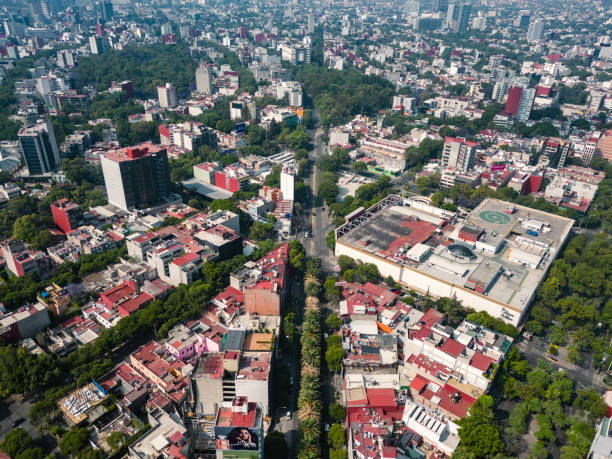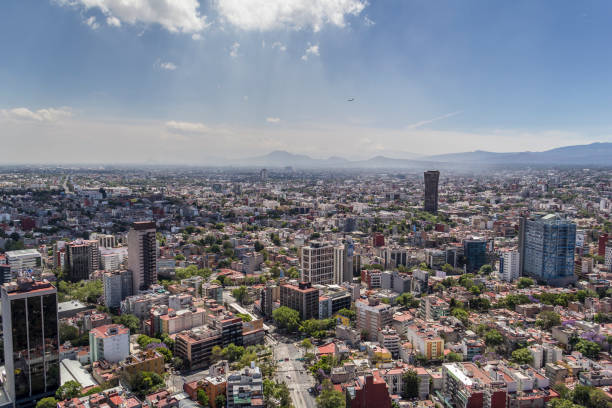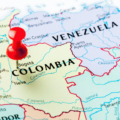Why Mexico City Is a Digital Nomad’s Dream Destination
Have you ever wondered if there’s a city that has it all for a remote worker? I’ve been a full-time digital nomad for years, writing and traveling under my blog name, “Jeff the chilled nomad,” and I can tell you that place exists. For me, it’s Mexico City.
As the largest city in Latin America, it offers this incredible mix of deep history, vibrant, modern culture, and a buzzing digital scene. It’s no wonder it was named one of the top destinations for remote work in 2024 by several travel publications.
The cost of living is affordable, the city is packed with amazing coworking spaces, and there are endless things to explore. If you’re looking for that perfect work-life balance in a place that constantly inspires you, this is it. So grab a coffee, and I’ll walk you through everything I’ve learned about making the most of this incredible city.
Key Takeaways
- Mexico City is surprisingly affordable for a major metropolis. You can find great apartments in top neighborhoods for a fraction of what you’d pay in the US or Europe, with monthly rent generally between $800 to $1,500 USD.
- The city has fantastic transportation, including an easy-to-use subway system and safe ride-hailing services like Uber and DiDi, which are my go-to for getting around.
- The best neighborhoods for digital nomads are easily Roma Norte and Condesa. They are packed with cafes, coworking spaces with fast Wi-Fi, and have a wonderfully walkable, green vibe.
- Understanding your tax situation is key. While you might not owe income tax if your earnings are from outside Mexico, you still need to register with the tax authorities (the SAT) and get an RFC number. Becoming a temporary resident can also offer tax benefits through Double Taxation Treaties (DTTs).
Cost Of Living In Mexico City For Digital Nomads
One of the first things you’ll love about Mexico City is how affordable it is. You can find fantastic accommodation, from modern apartments to cozy studios, for around $800 to $1,500 USD a month in the best areas.
Food is another area where you’ll save a ton. I practically lived off the delicious street tacos from local stalls, which cost next to nothing compared to restaurant meals. Even a full meal at a mid-range restaurant is very reasonable.
Getting around is also super cheap. The public transport is efficient, and ride-hailing apps like Uber or DiDi are my preferred way to travel after dark for just a few dollars.
Here’s a quick look at some average grocery prices I’ve found at local markets, which are always cheaper than the big supermarkets like Soriana or Chedraui.
- Milk (1 liter): 25 pesos
- Eggs (1 dozen): 40 pesos
- Artisanal Bread (1 loaf): 50 pesos
- Avocados (1 kilogram): 45 pesos
- Chicken Breast (1 kilogram): 140 pesos
- Local Craft Beer (1 bottle): 45 pesos
- A good bottle of Mexican wine: 200 pesos
Of course, these are just estimates to give you an idea. The best tip I can give you is to shop at the local *mercados*. The produce is fresher, and you’ll save a lot of money compared to the large chain grocery stores.
Affordable Accommodation Options
Finding a great place to live in Mexico City is easier than you might think. There’s a huge range of options that fit almost any budget. Platforms like Airbnb and Casai are fantastic for finding fully furnished apartments ready for you to move in.
I found a beautiful one-bedroom apartment in Roma Norte for about $1,100 USD a month, which is a great deal considering the location. If you want to save even more, you can look in neighborhoods just outside the main hubs, like Juarez or San Rafael, where you can find places for under $800 USD.
Many remote workers find that the overall monthly cost of living here is significantly lower than in other digital nomad hotspots. It allows you to enjoy a high quality of life without draining your savings.
Low Cost Food And Drink Options
The food scene in Mexico City is a huge part of the experience, and thankfully, it’s incredibly affordable. You can get some of the best food of your life for just a few dollars. My personal favorite is grabbing *tacos al pastor* from a street vendor after a night out, they are a must-try.
A meal at a budget-friendly restaurant, called a *comida corrida*, will often cost you less than $10 USD for multiple courses. Now, the nightlife here is amazing, but this is where your budget can take a hit. I learned pretty quickly that sticking to local beers like Victoria or Indio, or sharing a bottle of tequila with friends, is much easier on the wallet than ordering cocktails all night.
Reliable And Affordable Transportation Options
Getting around Mexico City is surprisingly simple and cheap. The city’s subway, the Metro, is incredibly efficient for covering long distances and connects almost the entire city. A single ride costs only about $0.25 USD, you really can’t beat that.
I recommend getting a rechargeable Integrated Mobility Card, which works for the Metro, the Metrobús, and even the EcoBici bike-sharing system. For times when you prefer private transport, especially late at night, ride-sharing apps like Uber and DiDi are widely available, safe, and very affordable.
And you should definitely try the EcoBici bike-sharing program. It’s perfect for shorter trips or just cruising around beautiful spots like Chapultepec Park or the leafy streets of Condesa.
Tax Requirements For Digital Nomads In Mexico
Let’s talk about the serious stuff for a minute, taxes. As a digital nomad in Mexico, you need to be aware of your obligations. If you earn all of your income from sources outside the country, you generally won’t be subject to Mexican income tax on that.
However, if you become a temporary or permanent resident, you must register with the Mexican tax authorities (known as the SAT) and get a tax identification number, called an RFC. This is a mandatory step.
It’s also worth looking into becoming an official resident. Mexico has Double Taxation Treaties (DTTs) with many countries, which can prevent you from being taxed in both your home country and Mexico. This can lead to some significant savings.
Best Neighbourhoods For Digital Nomads In Mexico City
Finding the right neighborhood is key to loving your time here. The most popular spots are Roma Norte and Condesa, and for good reason. They have everything you need, from amazing cafes to beautiful parks.
Let’s take a closer look at these areas to help you find the perfect fit for your lifestyle.
Roma Norte And Roma Sur
Roma Norte and Roma Sur are the heart of the digital nomad scene in Mexico City. Located just west of the historic center, these neighborhoods are a perfect mix of old-world charm and modern cool.
Roma Norte is famous for its gorgeous tree-lined streets, Art Deco architecture, and countless trendy cafes, like the popular Blend Station which is always full of people on laptops. It’s the place to be if you want a vibrant social life and to be surrounded by art galleries and amazing restaurants.
Roma Sur is a bit quieter and more residential, which can be a nice escape from the hustle. It has beautiful parks like the Jardín Pushkin, perfect for a sunny afternoon walk or an outdoor workout.

Condesa
Right next door to Roma is Condesa, another favorite among digital nomads. I personally love the vibe here. It’s known for its huge, beautiful parks like Parque México and Parque España, which are always full of people walking their dogs, jogging, or just relaxing.
Condesa feels a bit more upscale and is packed with amazing restaurants, chic boutiques, and a lively nightlife. You’ll find plenty of cozy cafes perfect for a work session, like Cardinal Casa de Café, which has fantastic coffee.
It’s an incredibly walkable neighborhood with a really strong community feel, making it an excellent choice if you want a great balance of work and play.

Pros And Cons Of Living In Each Area
Choosing between these amazing neighborhoods can be tough, so here’s a quick breakdown to help you decide. I’ve spent time in all of them, and each has its own unique charm.
| Neighbourhood | Pros | Cons |
| Roma Norte |
|
|
| Roma Sur |
|
|
| Condesa |
|
|
Ultimately, it comes down to your personal preference. Think about what matters most to you, whether it’s budget, atmosphere, or access to amenities, and you’ll find the perfect spot.
Co-Working Spaces with Wifi For Digital Nomads In Mexico City
Mexico City has an incredible coworking scene that has exploded in recent years. You’ll find everything from global brands to cozy, local spots with super-fast internet. It’s one of the reasons this city is such a great base for remote work.
I’ll share some of my favorite spots and what makes them stand out.
Top Coworking Spaces In Mexico City
The city is home to over 15 major coworking spaces, so you’ll have plenty of options. Here are some of the best ones that I’ve either used or have heard great things about from other nomads.
- WeWork – You know the name. They have multiple, beautifully designed locations all over the city with reliable service and great amenities.
- Impact Hub – This is a global network focused on social entrepreneurship. It’s a great place to connect with people who are working on meaningful projects.
- Nest Coworking – A really popular and affordable choice located right in the trendy Condesa neighborhood.
- PÚBLICO Coworking – This is a fantastic local chain with several locations. They have a great community feel and often host networking events.
- Homework – Another excellent local option known for its relaxed atmosphere and creative vibe.
- Centraal – This is a modern workspace in a great location, known for its bright, open design and natural light.
- IOS Offices – A more high-end option with stunning architecture and top-of-the-line tech infrastructure across several prime locations.
With such reliable Wi-Fi and so many dedicated workspaces, you’ll have no problem staying productive here. You can easily find a spot that fits your work style and budget.
Amenities And Features
The coworking spaces in Mexico City are seriously well-equipped. You can expect high-speed fiber optic internet, modern meeting rooms, and all the free coffee you can drink. Most also offer printing and scanning services and have fully stocked kitchenettes.
Some spaces go the extra mile with added perks. For example, many of the WeWork in Mexico City locations offer 24/7 access, which is amazing if you work in different time zones. They also have soundproof phone booths, ergonomic furniture, and community events that make it easy to meet people.
Networking Opportunities
One of my favorite things about working from Mexico City is how easy it is to connect with other people. The city is a major hub for entrepreneurs and remote workers from all over the world. Coworking spaces are the perfect place to start.
Many spaces host regular workshops, seminars, and happy hours that are designed for networking. It’s a fantastic way to meet potential collaborators or just make new friends.
Beyond the official spaces, I highly recommend joining a few Facebook and Meetup groups for digital nomads in Mexico City. They are super active and a great resource for everything from finding an apartment to organizing weekend trips.
The Digital Nomad Visa In Mexico City
Let’s clear up some confusion about the visa situation. Mexico has a Temporary Resident Visa that is perfect for remote workers. It allows you to stay in the country for more than 180 days and up to four years.
This is the official route to legally live and work remotely in Mexico for an extended period.
Temporary Resident Visa
The Temporary Resident Visa is the one you want if you plan to make Mexico City your home base for a while. It’s specifically for people who can prove they have a steady income from outside of Mexico, which is perfect for most digital nomads, freelancers, or retirees.
To qualify for this visa in 2025, you generally need to show proof of a monthly income of around $3,500 USD over the last six months. Another option is to show a savings account balance of approximately $58,000 USD over the past year. These numbers can change, so always check with the Mexican consulate nearest you for the most current requirements.
How To Apply
Getting your temporary resident visa is a multi-step process, but it’s totally manageable. Here’s a simple breakdown of what you need to do.
- Gather your documents: You’ll need a valid passport, the visa application form, proof of financial solvency (bank statements or pay stubs), and a passport-sized photo.
- Make an appointment: You have to apply at a Mexican consulate or embassy in your home country. You can’t do this from within Mexico.
- Attend your interview: You’ll have a short interview with a consular officer where you’ll submit your documents and pay the application fee.
- Get your visa sticker: If approved, they will place a visa sticker in your passport. This is your entry permit.
- Finalize in Mexico: Once you arrive in Mexico, you have 30 days to go to a local immigration office (INM) to complete the process and get your official temporary resident card.
This visa gives you the peace of mind to live and work here legally for the long term. It’s definitely worth the effort if you plan on staying longer than six months.
Pros And Cons Of Obtaining A Visa
Deciding to get a temporary resident visa is a big step. It’s important to weigh the benefits and drawbacks before you start the process.
| Pros | Cons |
| You can legally live and work remotely in Mexico for over 180 days. | The income requirements can be a challenge for some nomads to meet. |
| It opens the door to opening a local bank account and signing long-term leases. | The application process requires planning and must be done from your home country. |
| You can freely enter and exit the country without worrying about tourist visa limits. | You will need to register with the Mexican tax authority (SAT). |
| It’s the first step toward potentially gaining permanent residency in the future. | The process involves bureaucracy and can take several weeks to months. |
For me, the pros far outweighed the cons. Having the visa allows me to truly settle in and make Mexico City my home base without constantly looking over my shoulder.
Safety And Security Tips For Digital Nomads In Mexico City
One of the first questions people ask me about Mexico City is, “Is it safe?” The simple answer is yes, but like any massive city, you have to be smart. The main tourist and nomad neighborhoods are very safe.
You just need to use common sense and be aware of your surroundings.
Common Safety Concerns
Mexico City is generally safe, especially in areas like Roma, Condesa, and Polanco. However, the main thing to watch out for is petty theft, like pickpocketing. This is most common in very crowded places like the Metro during rush hour or the historic center.
I always recommend keeping your phone and wallet in your front pockets and never leaving your bag unattended. Another thing to be aware of is traffic. The drivers here can be aggressive, so always be extra careful when crossing the street.
Tips For Staying Safe
Staying safe here is mostly about making smart choices. After spending a lot of time in the city, here are the tips I always follow.
- Avoid walking alone late at night, especially in areas you don’t know well.
- Always use ride-sharing apps like Uber or Cabify instead of hailing a taxi on the street. It’s safer and the fare is set.
- Don’t flash expensive items like fancy cameras, jewelry, or large amounts of cash.
- Be aware of common scams, like someone “accidentally” spilling something on you to distract you while an accomplice tries to pick your pocket.
- Learning a few basic Spanish phrases goes a long way. It helps you navigate and shows respect.
- Stick to well-lit, busy streets, particularly after dark.
- It’s a good idea to register your trip with your country’s embassy before you arrive. This can be a huge help in case of an emergency.
By following these simple precautions, you can have an amazing and safe time exploring this vibrant city. It’s all about being mindful, not fearful.
Health And Wellness For Digital Nomads In Mexico City
It’s easy to maintain a healthy lifestyle in Mexico City, which is really important when you’re on the road. The city has excellent healthcare options, great fitness facilities, and a culture that embraces wellness.
You’ll have no trouble keeping your body and mind in great shape here.
Healthcare Options
As a digital nomad, having good healthcare is non-negotiable. The good news is that Mexico City has fantastic, high-quality medical care that is very affordable compared to the US or Europe.
Many nomads, myself included, use private hospitals and clinics, where you can often see a specialist for around $50 USD without an appointment. It’s also essential to have good travel medical insurance. I personally use a plan that covers emergencies, hospitalization, and even specialist visits.
Fitness And Wellness Facilities
Mexico City has a huge fitness culture. You’ll find tons of gyms, yoga studios, and wellness centers all over the city. Popular gym chains like Smart Fit and Sports World offer affordable memberships and have locations in almost every neighborhood.
If you’re into yoga or Pilates, studios like Green Yoga are very popular. Also, many of the modern apartment buildings, like those offered by Casai Apartments, come with their own private gyms. The abundance of fresh, cheap produce at local markets also makes it incredibly easy to eat healthy.
Mental Health Resources
Taking care of your mental health is just as important as your physical health, especially with the pressures of the nomad lifestyle. Mexico City has many resources to help you stay balanced.
Many coworking spaces and wellness centers offer yoga and meditation classes to help you de-stress. I also find that just taking advantage of the city’s beautiful parks, like Chapultepec Park or Parque España, for a walk can make a huge difference. If you need professional support, online therapy platforms like BetterHelp are easily accessible from Mexico and are a great resource for connecting with a therapist while you travel.
Things to do In Mexico City
You will never be bored in Mexico City. The city is a cultural powerhouse, bursting with incredible museums, art galleries, historic sites, and a music scene that is off the charts. Immersing yourself in the local culture is one of the best parts of living here.
Museums
Mexico City is home to over 150 museums, so there is truly something for everyone. Here are a few of my absolute must-visits.
- The National Museum of Anthropology: This place is world-class. It houses an unbelievable collection of artifacts from Mexico’s pre-Hispanic cultures, including the famous Aztec Sun Stone.
- The Frida Kahlo Museum: Also known as the Casa Azul, this was Frida’s actual home. It offers a deeply personal look into the life and work of this iconic artist.
- Soumaya Museum: The building itself is a work of art. Inside, you’ll find an impressive collection of over 66,000 pieces, including works by European masters like Rodin and Dalí.
- Museo Tamayo Arte Contemporaneo: If you’re into modern art, this is your spot. It features fantastic contemporary works from both Mexican and international artists.
- Palace of Fine Arts: This stunning building is worth visiting just for the architecture. It hosts major art exhibitions as well as performances by the Ballet Folklórico de México.
Exploring these museums is a great way to understand the incredible depth of Mexican culture. It’s an experience that goes way beyond just working from your laptop.
Art Galleries
The contemporary art scene in Mexico City is booming. The best place to start is in Roma Norte and Condesa, where you’ll find dozens of independent galleries showcasing cutting-edge work from local and international artists.
- Museo Soumaya: A must-see for its incredible architecture and diverse collection, including works by Mexican masters like Diego Rivera and Rufino Tamayo.
- Museo Nacional de Arte (MUNAL): This museum offers a comprehensive journey through the history of Mexican art, from the colonial period to the 20th century.
- Galería OMR: Located in Roma, this is one of the most influential contemporary art galleries in the city.
- Galería Enrique Guerrero: Also in Roma, this gallery is known for showcasing exciting contemporary artists from across Latin America.
- MUAC (Museo Universitario Arte Contemporáneo): Located on the UNAM campus, this museum features thought-provoking contemporary art exhibitions from around the globe.
- Casa Estudio Diego Rivera y Frida Kahlo: You can visit the former home and studio of these two artistic giants, which now functions as a museum.
- Museo Jumex: This is a major player in the contemporary art world, displaying impressive works from international artists in the upscale Polanco neighborhood.
The art here is so accessible. It’s a fantastic way to spend an afternoon and get inspired.
Historical Sites
Mexico City is built on centuries of history, and you can feel it everywhere you go. Exploring the city’s historical sites is like traveling back in time.
- Templo Mayor: Right in the heart of the city, you can explore the ruins of the main temple of the Aztec capital, Tenochtitlan. It’s an incredible archaeological site.
- National Museum of Anthropology: I know I mentioned it before, but it’s also a historical site, housing the most important collection of artifacts from Mexico’s ancient civilizations.
- Palace of Fine Arts: This beautiful building is not just an art venue; it’s a piece of history itself, famous for its stunning murals by Diego Rivera.
- Chapultepec Castle: Perched on a hill in Chapultepec Park, this castle has served as a military academy and a presidential residence. It now offers amazing views and exhibits on Mexican history.
- Basilica de Guadalupe: This is one of the most important Catholic pilgrimage sites in the world, a stunning example of modern religious architecture.
- Teotihuacan Pyramids: Just a short bus ride from the city, you can climb the ancient Pyramids of the Sun and Moon. It’s an unforgettable day trip.
- Coyoacán & Frida Kahlo Museum: The historic neighborhood of Coyoacán feels like a small colonial town, and it’s where you’ll find Frida Kahlo’s famous Blue House.
These sites give you a real connection to the city’s incredible past.
Music Venues
The nightlife in Mexico City is legendary, and the music scene is a huge part of that. I’ve had some of my most memorable nights out here. There’s a venue for every taste.
- El Plaza Condesa: A popular mid-sized venue that hosts a great mix of local and international bands.
- Foro Indie Rocks!: This is a smaller, more intimate space in Roma that is perfect for discovering new indie bands and DJs.
- Zinco Jazz Club: An amazing underground jazz club in the historic center. It feels like stepping into another era.
- Auditorio Nacional: One of the biggest and most famous venues in Latin America, where you can see major international superstars.
- Mama Rumba: If you want to experience salsa, this is the place. It’s always packed with incredible dancers and has a fantastic live band.
- Patrick Miller: This is an experience you have to try at least once. It’s a massive, no-frills dance party every Friday night dedicated to 80s high-energy music, and the energy is absolutely electric.
I remember one Friday night heading to Patrick Miller with some friends I’d met. The place was packed, with incredible dancers having organized dance-offs in the middle of the floor. It was one of the most fun, unpretentious nights of dancing I’ve ever had.
Festivals And Events
There is always something happening in Mexico City. The city’s calendar is packed with vibrant festivals and events that are amazing to experience.
- Day of the Dead (Día de Muertos): Celebrated on November 1st and 2nd, this is Mexico’s most iconic cultural event. The entire city comes alive with parades, altars, and celebrations honoring loved ones.
- Vive Latino: This massive music festival in the spring is one of the most important Latin American music festivals in the world.
- International Book Fair (FIL): Held in November, this is a huge event for book lovers, attracting authors and publishers from all over the globe.
- Festival de México en el Centro Histórico: This festival in March fills the historic center with concerts, dance performances, and art exhibitions.
- Zona MACO Art Fair: Held in February, this is Latin America’s leading contemporary art fair, attracting collectors and artists from around the world.
- Corona Capital Music Festival: This major festival in November brings huge international rock and indie bands to the city.
Participating in these events is a fantastic way to dive deep into Mexican culture.
Transportation In Mexico City
You don’t need a car to live in Mexico City. The city has a fantastic and affordable public transportation system, along with bike-sharing programs and reliable ride-hailing services. It’s one of the easiest big cities to navigate.
Public Transport Options
The public transport here is efficient and will get you almost anywhere you need to go. Here are the main options I use all the time.
- Metro: The subway is the fastest way to travel long distances. It has 12 lines, can get crowded during rush hour, but is incredibly cheap at only 5 pesos per ride.
- Metrobús: These are dedicated-lane buses that are a great alternative to the Metro. They are modern, and many routes offer free Wi-Fi.
- Colectivos: These are shared vans that run on fixed routes. They are a bit more chaotic but are a fast and cheap way to get around specific neighborhoods.
- Taxis & Ride-Hailing: Always use official taxis or ride-hailing apps like Uber or Cabify. It’s safer and you won’t have to haggle over the price.
Using public transport is a great way to save money and experience the city like a local.
Bike Sharing Programs
Mexico City has one of the best bike-sharing programs in Latin America, called EcoBici. It’s my favorite way to get around for shorter distances, especially in flat, bike-friendly areas like Roma and Condesa.
The system is easy to use. There are over 480 stations across the city, so you can easily pick up a bike and drop it off at a station near your destination. Each ride gives you up to 45 minutes, which is usually more than enough time.
Using EcoBici has become a huge part of the city’s culture. It’s a fun, healthy, and eco-friendly way to explore.
Ride-hailing Services
For convenience and safety, ride-hailing services like Uber and DiDi are essential tools for any digital nomad in Mexico City. They are reliable, affordable, and available 24/7. I use them almost daily, especially when coming home late at night.
The service is generally excellent, and you can even find options for shared rides to save more money. It takes all the stress out of getting from point A to point B.
Driving In Mexico City
Honestly, I would not recommend driving in Mexico City. The traffic is famously intense, drivers can be aggressive, and finding parking is a constant challenge. It can be a very stressful experience.
Between the excellent public transit and affordable ride-hailing services, there is really no need to have a car here. You’ll save yourself a lot of time, money, and headaches by sticking to the other options.
Conclusion: Final Thoughts And Summary Of Mexico City As A Digital Nomad Destination
So, is Mexico City the perfect destination for digital nomads? In my experience, it comes pretty close. This updated 2025 mexico city digital nomad guide should give you all the info you need to get started.
The combination of a low cost of living, a vibrant and inspiring culture, and all the amenities a remote worker could need makes it an incredible place to live. It’s a city that has something for everyone.
Whether you’re looking for world-class food, incredible history, or a thriving community of fellow nomads, you will find it here. I hope this guide helps you fall in love with this amazing city as much as I have.
FAQs:
- What are the best coworking spaces in Mexico City for digital nomads?
You have so many great choices. Big names like WeWork are always reliable, but I also recommend checking out local favorites like PÚBLICO and Homework for a more community-focused vibe.
- How can I find affordable accommodation as a digital nomad in Mexico City?
Airbnb is a great place to start, especially for your first month. For longer-term stays, I’d suggest looking at local rental sites or joining Facebook groups for expats and nomads in Mexico City where people often post listings.
- What are some must-visit places for digital nomads in Mexico City?
You absolutely have to visit the National Museum of Anthropology, it’s mind-blowing. I also recommend spending a full day exploring the historic center, and of course, wandering the beautiful streets and parks of Roma Norte and Condesa.
- Is it safe for me to work remotely from public spaces such as parks and cafes?
Yes, it’s generally very safe to work from public places, but you should always be smart about it. Keep an eye on your belongings, especially your laptop and phone, and don’t leave them unattended, even for a second. Choose a spot where you can keep your back to a wall if possible.
More Info…
Live and work in mexico
Living and working in Mexico offers a truly enriching experience. The country is famous for its deep history, incredible food, and friendly, vibrant culture. Key job sectors here include tourism, automotive manufacturing, and a rapidly growing tech scene.
The cost of living is much lower than in most of Europe or North America, which allows you to enjoy a higher quality of life. The local communities are also incredibly welcoming, which makes it easy to settle in and feel at home.
Spanish is the official language, and while you can get by with English in the main nomad hubs, learning some Spanish will open up so many more opportunities for connection and work. It’s an amazing place for personal growth and a fantastic change of pace.
Internet speed in Mexico city
The internet in Mexico City is generally fast and reliable, especially in the main residential and business areas. According to the Speedtest Global Index, Mexico’s average fixed broadband download speed is quite competitive, and in a major hub like Mexico City, it’s often even better.
Major providers like Telmex and Totalplay offer fiber-optic plans with speeds that are more than enough for video calls, streaming, and any other work you need to do. While you might find slower speeds in less developed neighborhoods, the areas popular with nomads are very well-connected.
Best time to visit mexico
The best time to visit Mexico really depends on what you’re looking for. The dry season, from November to April, is generally considered the best time. The weather is mild and pleasant, perfect for exploring cities or relaxing on the beach.
The summer months, from May to October, are the rainy season, which means hot, humid weather and afternoon downpours. It’s important to remember that hurricane season runs from June through November, so be cautious if you’re planning a trip to coastal areas during that time.
Cons of living in mexico
While I love living in Mexico, it’s important to be realistic about the challenges. Safety can be a concern in certain parts of the country, though the main expat areas are generally secure. You do need to be aware of issues like petty crime.
Navigating the bureaucracy for things like visas or banking can be slow and frustrating at times. While the cost of living is low, wages for local jobs are also lower, which is something to consider if you plan to find local work. Finally, the quality of public infrastructure can vary greatly from place to place.


























